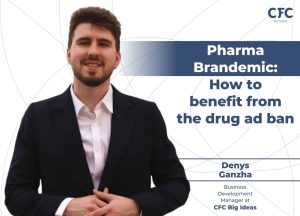
This decision was made by Ukraine’s National Security Council in August 2021 and is undoubtedly being fought by different associations right now. The Four Drugs Roundtable, organized as part of the Pharma&Digital Forum in September 2021, called on the government and all political parties to invest more resources in reforming advertising legislation and raising public awareness of the dangers of self-medication.
And yes, the new reality can be altered with the efforts of associations and the issuing of joint statements—and hopefully the pharma and media businesses will succeed. But this situation can be seen from a different side. Every ban is also a window of opportunity: the text of the decree implementing the Security Council’s decision says nothing about banning the advertising of pharmaceutical brands.
So far, pharma brand communication has not been the easiest to do. But the COVID-19 pandemic has caused a real “brandemic” in the vaccine-developing industry.
Pfizer, AstraZeneca, Moderna… These names are now on the lips of every Ukrainian. Before 2020, it’s safe to say only a small percentage of people knew these brand names. In the US, only 32% of ordinary Americans were positive about Big Pharma in January 2020, yet just a few months later, this number had nearly doubled, to 62%. Social media users began writing posts with hashtags like #TeamModerna or #PfizerGang. But the most important change is that, while few individuals know that they were vaccinated with Comirnaty, the Pfizer vaccine, they can all say: “I got Pfizer.”
Of course, this has all happened quite coincidentally and brand awareness was helped by a terrible pandemic that took millions of lives. The thing is that Ukraine’s pharmaceutical companies, not being major vaccine developers, face a harder challenge. Right now, the best way forward for these companies is to strategically promote their brands rather than relying on advertising individual drugs.
Strange as it might sound, Ukrainian pharma could learn from its “ideological antagonist,” the tobacco industry. Although a total ban on cigarette advertising came into force back in 2012, the tobacco industry is still one of the biggest spenders on marketing in Ukraine. According to WHO, $23 million is spent DAILY on tobacco marketing all over the world. Tobacco companies are investing in creative marketing, social responsibility and a presence at big festivals and other events. Given its positive mission, pharma could advertise even more effectively.
No ban will stop companies with Big Ideas.
So what can Ukraine’s pharma do in order to come out a winner in 2024 and use the ban as an opportunity? Make your brand sell. Job #1 that every manager must set for the communication team is “Our brand name has to be on the lips of 100% of our target audience.”
To get there, here’s a practical roadmap:
1. Promote your brand through social projects
It’s long been known that social projects have a significant impact on consumer loyalty. Look for universal issues that will help your brand become a leader in social responsibility. Here, you can come up with new areas of engagement—from providing learning opportunities for students to constant contact with consumers at festivals, sports events and even concerts.
2. Set up a network of direct contact with consumers without intermediaries.
This is a completely new direction that it is rapidly gaining momentum. Connecting with consumers directly through your company’s daily tools can generate additional revenue for your pharmaceutical brand. Develop a network of medical reps and open direct POS for medications—both off- and online.
3. Represent your brand “to the max” without focusing on specific drugs in online pharmacies and medical marketplaces.
Today, the share of e-commerce in Ukraine’s pharmaceutical market is already 7%, but by 2026 it is expected to rise to 15%, which is 5% higher than the world average. Indeed, this trend will continue, especially after the ban on advertising drugs. Look for the most effective mechanisms for working with such marketplaces as Liki24, and start signing solid cooperation agreements.
For one thing, Ukraine’s pharma businesses urgently need to set up new partnerships, whether it’s cooperating to counter the ban or completely new, even unexpected ways of developing. Keep in mind that any ban brings major changes that can lead to a perfect storm for the emergence of strong new ideas. Better to face this storm on a powerful, nimble platform, the foundation of which is your brand.


